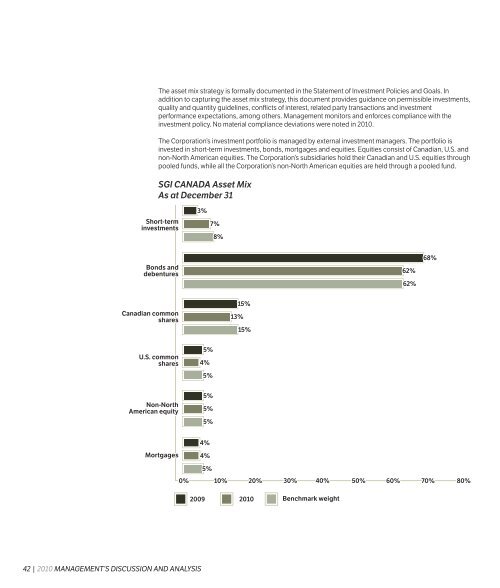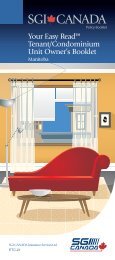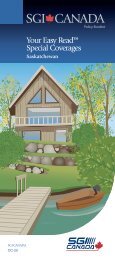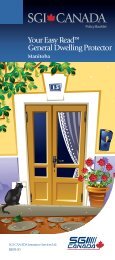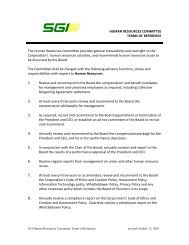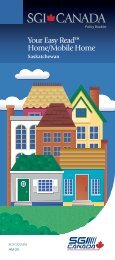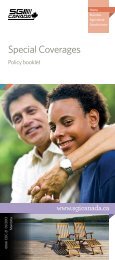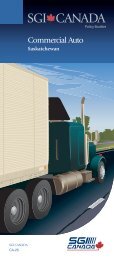Full report - SGI Canada
Full report - SGI Canada
Full report - SGI Canada
You also want an ePaper? Increase the reach of your titles
YUMPU automatically turns print PDFs into web optimized ePapers that Google loves.
Credit ratings for the bonds and debentures are as follows:<br />
Credit Rating<br />
Fair Value<br />
2010 2009<br />
Makeup of<br />
Portfolio<br />
(thousands of $)<br />
Fair Value<br />
Makeup of<br />
Portfolio<br />
Foreign exchange risk<br />
The Corporation is subject to changes in the U.S./Canadian dollar exchange rate on its U.S. equity<br />
investments, purchases of goods and services that are denominated in U.S. dollars, and a portion of claims<br />
and reinsurance receivables and payables denominated in U.S. dollars. Also, the Corporation is exposed<br />
to Europe, Australasia and Far East (EAFE) currencies through its investment in the non-North American<br />
Pooled Fund. Exposure to both U.S. equities and non-North American equities is limited to a maximum<br />
7% each of the market value of the total investment portfolio, excluding investments accounted for on the<br />
equity basis and preferred shares. At December 31, 2010, the Corporation’s exposure to U.S. equities was<br />
5.2% (2009 – 5.2%) and its exposure to non-North American equities was 5.4% (2009 – 4.6%).<br />
AAA $ 197,639 53.9% $ 202,557 51.5%<br />
AA 82,539 22.5% 84,534 21.5%<br />
A 65,765 17.9% 86,160 21.9%<br />
BBB 21,042 5.7% 19,877 5.1%<br />
Total $ 366,985 100.0% $ 393,128 100.0%<br />
Within bonds and debentures, there are no holdings from one issuer, other than the Government of<br />
<strong>Canada</strong> or a Canadian province, over 10% of the market value of the combined bond and short-term<br />
investment portfolios. No single holding of a province is over 20% of the market value of the bond portfolio.<br />
The unit value of the mortgage pooled fund is impacted by the credit risk of the underlying mortgages.<br />
This risk is limited by restrictions within its own investment policy, which include single loan limits,<br />
diversification by property type and geographic regions within <strong>Canada</strong>.<br />
Through its custodian, the Corporation participates in an investment security lending program. Collateral<br />
of at least 102% of the market value of the loaned securities is held for the loan. This collateral is marked<br />
to market on a daily basis. In addition, the custodian provides indemnification against any potential<br />
losses in the securities lending program. At December 31, 2010, the Corporation had $78,141,000<br />
(2009 – $40,139,000) of securities on loan under the program and held collateral of $82,048,000 (2009 –<br />
$42,149,000).<br />
Credit risk associated with reinsurers is managed through regular monitoring of credit ratings of the<br />
reinsurers utilized by the Corporation. Reinsurers’ credit ratings range from AA+ to A- based on the most<br />
recent ratings by A.M. Best.<br />
Market risk<br />
Market risk represents the potential for loss from changes in the value of financial instruments. Value can<br />
be affected by changes in interest rates, foreign exchange rates and equity prices. Market risk primarily<br />
impacts the value of investments.<br />
Interest rate risk<br />
The Corporation is exposed to changes in interest rates in its fixed income investments, including shortterm<br />
investments, bonds and debentures, and the mortgage pooled fund. It is estimated that a 100 basis<br />
point increase/decrease in interest rates would decrease/increase other comprehensive income and<br />
accumulated other comprehensive income by $11.5 million at December 31, 2010 (2009 – $18.1 million),<br />
representing 2.6% of the $435.2 million fair value (2009 – 4.2%, $435.1 million) of fixed income investments.<br />
At December 31, 2010, a 10% appreciation/depreciation in the Canadian dollar versus U.S. dollar<br />
exchange rate would result in approximately a $3.1 million (2009 – $3.0 million) decrease/increase in other<br />
comprehensive income and accumulated other comprehensive income. A 10% appreciation/depreciation<br />
in the Canadian dollar versus the EAFE currencies would result in approximately a $3.2 million (2009 –<br />
$2.7 million) decrease/increase in other comprehensive income and accumulated other comprehensive<br />
income. As U.S. common shares, the U.S. equity pooled fund and the non-North American equity pooled<br />
fund are classified as available for sale, any unrealized changes due to foreign currency are recorded as<br />
other comprehensive income and do not directly impact net income until the investment is sold.<br />
The Corporation’s exposure to foreign exchange risk within its bond and debenture portfolio is limited to<br />
a maximum 5% of the market value of the bond and debenture portfolio. As well, no more than 10% of the<br />
market value of the bond portfolio shall be invested in bonds of foreign issuers.<br />
The Corporation’s exposure to exchange rate risk resulting from the purchase of goods and services, and<br />
claims and reinsurance receivables and payables, are not considered material to the operations of the<br />
Corporation.<br />
Equity prices<br />
The Corporation is exposed to changes in equity prices in Canadian, U.S. and EAFE markets. Equities<br />
comprise 26.4% (2009 – 24.7%) of the carrying value of the Corporation’s total investments. Individual<br />
stock holdings are diversified by geography, industry type and corporate entity. No one investee or related<br />
group of investees represents greater than 10% of the market value of the Corporation’s common share<br />
portfolio. As well, no one holding represents more than 10% of the voting shares of any corporation.<br />
The Corporation’s equity price risk is assessed using Value at Risk (VaR), a statistical technique that<br />
measures the potential change in the value of an asset class. The VaR has been calculated based on<br />
volatility over a four-year period, using a 95% confidence level. As such, it is expected that the annual<br />
change in the portfolio market value will fall within the range outlined in the following table 95% of the time<br />
(19 times out of 20 years).<br />
Asset Class 2010 2009<br />
(thousands of $)<br />
Canadian pooled equity fund and<br />
Canadian common shares $ +/- 36,613 $ +/- 32,877<br />
U.S. pooled equity fund and U.S.<br />
common shares +/- 8,054 +/- 7,542<br />
Non-North American pooled equity fund +/- 11,128 +/- 9,147<br />
84 | 2010 NOTES TO THE CONSOLIDATED FINANCIAL STATEMENTS NOTES TO THE CONSOLIDATED FINANCIAL STATEMENTS 2010 | 85


